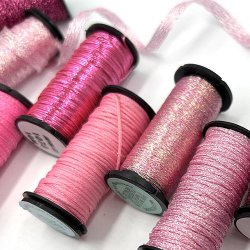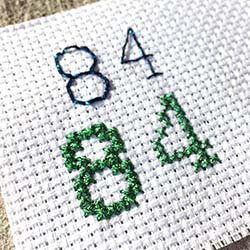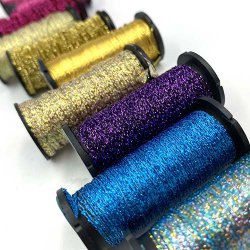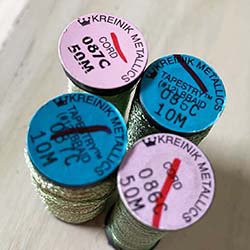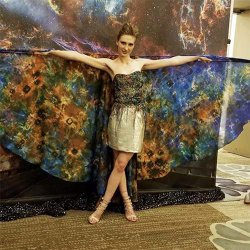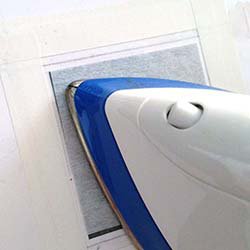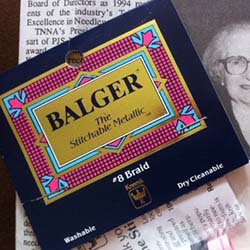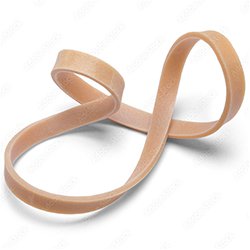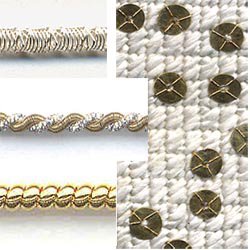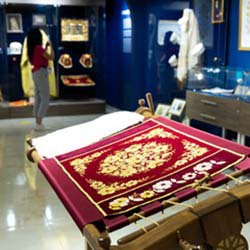Metallic Thread
Tips and ideas for using Kreinik metallic threads.
-
Kreinik Metallic Thread Widths
Jewelry makers and other fiber artists often choose thread by their width. Whether you’re working with wire, beads, needles, or general crafts, now you can choose the right Kreinik thread width for your project.
mm means millimeter
KREINIK THREAD NAME + WIDTH
#32 Braid, basic colors 1.5mm
#32 Braid, fluorescent colors 1.4mm
#32 Braid, hi lustre colors 1.6mm
#32 Braid, cord colors 1.5mm#16 Braid, basic colors .78mm
#16 Braid, fluorescent colors .87mm
#16 Braid, hi lustre colors 1.2mm
#16 Braid, cord colors .81mm
#16 Braid, Japan colors 1.6mm#12 Braid, basic colors .61mm
#12 Braid, fluorescent colors .63mm
#12 Braid, hi lustre colors .65mm
#12 Braid, cord colors .60mm
#12 Braid, Japan colors .54mm#8 Braid, basic colors .50mm
#8 Braid, fluorescent colors .57mm
#8 Braid, hi lustre colors .55mm
#8 Braid, cord colors .58mm
#8 Braid, Japan colors .43mm#4 Braid, basic colors .35mm
#4 Braid, fluorescent colors .54mm
#4 Braid, hi lustre colors .32mm
#4 Braid, cord colors .30mm
#4 Braid, Japan colors .39mmFacets 1.61mm
Petite Facets .98mmJapan #1 .15mm
Japan #5 .39mm
Japan #7 .51mm -
How to calculate thread amount
For cross stitch or needlepoint
The following offers guidance for determining how much thread you may need to stitch your project. Knowing exactly how much thread you will need for a project is not an exact science. There are many factors that vary from project to project and stitcher to stitcher.
This info comes from stitchers who provided us with the information based on their projects. Stitching techniques and tension may vary from person to person, so you may want to stitch an inch or stitch a test area and calculate how much thread was required. Then use that measurement to guesstimate on your project area. We suggest adding an additional 10% to 20% to include a margin of error (variances in stitch techniques, whether you have to rip out, how much thread is used to start and stop, etc)
Keep in mind that specialty stitches take extra thread, so the comments below are only for Tent Stitch or the Cross Stitch.
- NEEDLEPOINT: The formula for yardage calculation for TENT STITCH is The square inches to be worked x 1.5 = thread yardage needed. That is based on using 1.5 yards to complete a 1” square. So, calculate the square inches of the area you are stitching and multiply it times 1.5 to get the amount of thread in yards that you need.
- CROSS STITCH: On 18 count Aida, it took 95 inches of Very Fine #4 Braid to stitch a 1-inch square.
- CROSS STITCH: On 18-count Aida, it took 98 inches of Fine #8 Braid to stitch a 1-inch square
- CROSS STITCH: On 14 count Aida, it took 75 inches of Very Fine #4 Braid to stitch a 1-inch square
- CROSS STITCH: On 14-count Aida, it took 78 inches of Fine #8 Braid to stitch a 1-inch square
-
Metallic Thread Selection Guide
Which Kreinik metallic thread works best in Cross Stitch? Which Kreinik metallic thread can you use in a sewing machine? These selection questions and more answered below:
CARD MAKING, SCRAPBOOKING:
- Stitching on paper: Cord, Very Fine #4 Braid, Fine #8 Braid
- Ribbons: 1/16" Ribbon, 1/8" Ribbon
- Iron-on 1/8" Ribbon and Iron-on Medium #16 Braid
COSPLAY, COSTUMING, FASHION:
- See "Hand Embroidery" or "Machine Embroidery" lists (below)
- Iron-on 1/8" Ribbon and Iron-on Medium #16 Braid
CROCHET:
- Carry-along: Blending Filament, Ombre, Reflective Yarn
- Jewelry: Tapestry #12 Braid, Medium #16 Braid, Canvas #24 Braid
- Bead crochet: Fine #8 Braid, Tapestry #12 Braid
CROSS STITCH:
- Blending Filament (use by itself or combined with other thread like cotton embroidery floss)
- Cord (backstitching, couching)
- Very Fine #4 (on 16- and 18-count Aida or over two threads on 28-, 32-count linens)
- Fine #8 (on 14-count Aida, or over two threads on 28-count)
- Tapestry #12 Braid (12-count fabrics)
- Medium #16 Braid (11-count fabrics)
- 1/16" Ribbon (10- to 11-count fabrics)
- 1/8" Ribbon (6- to 8-count fabrics)
- Cross stitching on unusual materials, like pegboard, screens, etc? Go up to one of our larger Braids, such as Medium #16 Braid, Canvas #24 Braid, or Heavy #32 Braid); the larger the Braid number, the heavier the thread.
HAND EMBROIDERY:
- Stitch in and out of the fabric: Cord (for very fine details), Very Fine #4 Braid, Fine #8 Braid
- Couch for surface embellishment: Medium #16 Braid, Canvas #24 Braid, Heavy #32 Braid, 3/8" Trim, Facets, Petite Facets, Micro Ice Chenille, Wired Braid, 3/8" Trim
- Ribbon embroidery stitches: 1/16" Ribbon, 1/8" Ribbon, 1/4" Ribbon, Easter Grass
- Dimensional, shaped stitches: 3/8" Trim with wire, Wired Braid
KNITTING:
- Carry-along: Blending Filament, Ombre, Reflective
- Bead Knitting: Fine #8 Braid, Tapestry #12 Braid
MACHINE EMBROIDERY and QUILTING:
- In the needle: Cord, Japan #1
- In the bobbin: Ombre, #4 and #8 Braids, Cord
- Couched: Facets, Petite Facets, Micro Ice Chenille, Ribbons, Braids (all sizes), Wired Braid, 3/8” Trim, Cable, Japan #5, 7
- Iron-on 1/8" Ribbon and Iron-on Medium #16 Braid (for quilt embellishments)
NEEDLEPOINT:
- Blending Filament (if blending with other fibers) (also can be used on 40-count silk gauze)
- Cord (backstitching, couching)
- Cable (3-ply twist for specialty stitches on any canvas)
- Very Fine #4 Braid (blending on any canvas)
- Fine #8 Braid (18-, 24-count)
- Tapestery #12 Braid (18-, 14-count)
- Medium #16 Braid (14-, 13-count)
- Canvas#24 Braid (13-, 12-count)
- Heavy #32 Braid (12-, 10-count)
- Ombre (18-count canvas, or specialty stitches)
- Couched: Petite Facets, Facets, Micro Ice Chenille, 3/8” Trim, Wired Braid, Japan Threads
- Ribbons: 1/16” (24-, 18-count canvas); 1/8” (14-, 13-count); 1/4” (12-, 10-count), Easter Grass (any canvas)
PUNCHNEEDLE:
- Blending Filament (#1 needle)
- Very Fine #4 Braid (#1 and #3 needles)
- Fine #8 Braid (#3 needle)
PLASTIC CANVAS:
- Medium #16 Braid (14 count)
- Canvas #24 Braid (10-count)
- Heavy #32 Braid (7 count)
- 1/8" Ribbon (7-10 count)
MIXED MEDIA, CRAFTS, STRING ART, OTHER FIBER ARTS:
- All fibers
SAMPLERS:
- Cord (backstitching, couching)
- Very Fine #4 Braid (over two threads on 28-, 32-, 36-count linens)
- Fine #8 Braid (over two threads on 28-count linens)
- Cable (long stitches and specialty stitches)
- 1/16" Ribbon (woven stitches)
SASHIKO:
- Very Fine #4 Braid
- Fine #8 Braid
- Tapestry #12 Braid
- 1/16" Ribbon
SWEDISH WEAVING:
- Very Fine #4 Braid
- Fine #8 Braid
- 1/16" Ribbon
- 1/8" Ribbon
TEMARI:
- Fine #8 Braid
- Tapestry #12 Braid
- Japan thread
- 1/16" Ribbon
WEAVING:
- Warp: Ombre, Ribbons (basic colors), Braids (basic colors)
- Weft: Micro Ice Chenille, Ombre, Ribbons and Braids (any color)
-
Discontinued Kreinik metallic colors
We hate to discontinue any thread color, but sometimes it is required due to manufacturing problems (for example, if we can't get the raw material to transform it into your favorite Kreinik threads). You will find the list of discontinued colors below. If you have these in your stash, we recommend putting a mark on the label to indicate a discontinued color.
Important tips for stitchers who buy thread stashes on Ebay, at estate sales, and Goodwill/Salvation Army stores:
- The thread dye lot most likely has changed. Mark those threads so you know and won't get caught running out mid project.
- Some of those threads may be discontinued. Google search or contact the manufacturer to double check before you use them in a project (and end up needing more).
Discontinued Kreinik colors and substitution suggestions:
NM means no close match
- 003C Red Cord = 003 Red
- 005C Black Cord = 005 Black
- 007C Pink Cord = 007 Pink
- 008C Green Cord = 008 Green
- 011C Nickel Cord = 010HL Steel Grey
- 012C Purple Cord = 012 Purple
- 022L = 052HL Bronze
- 026L = 026 Amethyst
- 027L Orangeruptis = 027 Orange
- 029L = 029 Turquoise
- 031L Berry Red = 153V Vintage Burgundy
- 032C Pearl Cord = 032 Pearl
- 034 Confetti = NM
- 041 Confetti Pink = 044 Confetti Blue
- 041C Confetti Pink Cord = 044 Confetti Blue
- 042 Confetti Fuchsia = NM
- 042L Optic Opal = NM
- 043 Confetti Green = NM
- 051C Sapphire Cord = 051HL Sapphire Hi Lustre
- 056F Blueberry = NM
- 057F Grape = NM
- 070 Mardi Gras = 5011 Elfin Green
- 080 Garnet in Miro Ice Chenille = Red is a bolder version
- 080C Garnet Cord = 080HL Garnet Hi Lustre
- 086C Fern = 4201 Sugar Cane
- 087C Meadow Grass = 089 Aspen
- 088C Lily Pond Cord = 4201 Sugar Cane
- 104C Colonial Gold Cord = 102C Vatican Gold Cord
- 195 Sunburst = 095 Starburst
- 202C Indigo Cord = 018 Navy
- 225C Slate Cord = 4204 Storm Cloud
- 2094HL Heather Hi Lustre = NM
- 235 Red Ember = 307 Deep Coral
- 271 Plum = 3223 Ametrine
- 664 Magenta Blue = NM
- 3240 Opal = 095 Starburst
- 3508 Rhumba Green = 829 Mint Julep
- 3509 Cha Cha Verde = 008HL Green Hi Lustre
- 3540 Bolero Black = 005 Black
- 393 Silver Night = 622 Wedgewood Blue
- 4001 Green Tea = 4201 Sugar Cane
- 4002 Spiced Chai = 4202 Dusky Meadow
- 4003 Ginseng Gold = 4203 Cattail
- 4004 Earl Grey = 4204 Storm Cloud
- 4005 Sugar Cube = 102 Vatican Gold
- 4006 Rosehip = 007 Pink
- 4639 Light Aqua = 3214 Blue Zircon
- 5002 Pixiedust = NM
- 5004 Love Potion = 024L Fiery Fuchsia
- 5007 Brocade = 5006 Ore
- 5008 Leprechaun = 009 Emerald
- 5500 PInk Lemonade - 5700 Cotton Candy
- 5525 Lemon = 5725 Lollipop Lemon
- 5530 Rosemary Green = 4201 Sugar Cane
- 9132 Lemongrass = 5725 Lollipop Lemon
- 9300 Orchid = NM (closest pastel is slightly darker 093 Star Mauve)
- Easter Grass in 1/8" Ribbon size (Easter Grass still available in 1/16" and 1/32")
- Marine Blue in Micro Ice Chenille = NM
- Petite/Facets 012 = Petite/Facets 026
- Petite/Facets 029L = NM
-
Kreinik on costumes in the movies
Kreinik: embroidery threa
dto the starsIt may come on any normal, routine day at the Kreinik thread factory: a phone call from a costume company that will get everyone excited and Googling current movies in production. "We're going to be worn by celebrities, again!" We can't help being starstruck when Kreinik threads show up in a movie. From the early days of the company when Jerry and Estelle sold threads to famed costume designer Nudie Cohn, to the present day, Kreinik threads have been on stage and screen.
When a costume designer or costume company calls, they usually can't say what production they're working on due to production confidentiality (we still try to guess). They usually describe a period costume or a certain look they want to reproduce, and we come up with the Kreinik threads that match. The result is stunning embroidery or trim that helps bring a character, mood, and theme to life.
Metallic threads show up well on stage and screen due to their light-reflecting properties, plus they are modern, easy-to-use materials replacing expensive, heavy real metal trims and embellishments. The most popular Kreinik threads used on costumes tend to be our heavier Braids, our Ribbons, and our 3/8" Trim. A few hundred meters of Kreinik #8 and #12 Braids appear as the gold embroidery on costumes in Hocus Pocus 2, for instance. And Kreinik 3/8" Wired Trim created dimensional, detailed embroidery in Game Of Thrones (we really stand out on Queen Cersei's robe in one dramatic scene).
We were excited to work with the talented costume designer Michele Carragher throughout the seasons of Game of Thrones. We even had to rush threads to filming sites a few times. Here you can see some of the costumes: https://www.michelecarragherembroidery.com/game-of-thrones
Michele's career reflects her love of and talent for detailed embroidery. Michele has used Kreinik threads on costumes in other productions. She shares these photos (below) of gowns in the movie "Queen of the Desert," released in 2015 starring Nicole Kidman. Michele worked on ball gowns and corsages for Nicole's character in the film. See more of Michele's stunning costume and clothing designs here: https://www.michelecarragherembroidery.com/
It's exciting to work with costume designers, and even more exciting to see the same threads you use for your needlepoint/cross-stitch/embroidery featured on an actor or actress. When you watch movies and episodes where there's embroidery on costumes, see if you can spot any Kreinik threads.
And if you are a costume designer or work for a production company—from local theatre to Broadway, from opera to movies, from cosplay events to Halloween costumes—you will find a Kreinik thread to make your embroidery and embellishment visions come to life.
-
Kreinik thread content
Below you will find the material content for Kreinik threads:
- Braid/Ribbon/Filament Hi Lustre colors: 62% polyester, 38% nylon
- Braid/Ribbon/Filament Holographic colors: 100% polyester
- Braid/Ribbon/Filament Vintage colors: 64% polyester, 36% nylon
- Braid/Ribbon/Filament Fluorescent colors: 80% polyester, 20% nylon
- Braid/Ribbon/Filament Basic colors: 65% polyester, 35% nylon
- Ombre colors: 65% polyester/35% nylon
- Micro Ice Chenille colors: cotton core, polyester metallic
- Cord, black core colors: 28% polyester, 72% rayon
- Cord, solid core colors: 37% polyester, 635 rayon
- Silk Mori: 100% spun silk
- Silk Serica: 100% filament silk
- Silk Bella: 100% filament silk
-
Thread bleeding advice
Test a metallic, silk, cotton, or rayon thread for bleeding
It's a potential disaster that every stitcher fears: a thread color bleeding. While most colors are safe, there are others with reputations: reds, oranges, greens for instance. What can you do if you've washed your needlework and discovered a bleed? Read on for tips from stitchers. We have not tested these, so you may want to try them on scrap stitching first*.
Suggestions:
- "Prewash any thread that could possibly bleed. Let dry before using in stitching."
- "Soak the piece in ice cold water until the color starts to come out. Then, rub ice cubes over the area and put it back into fresh ice water and soak again. Repeat these steps using clean water until the area is clear." See Carina's Craft Blog here for her test of this cold-water technique.
- "Rinse and repeat. Rinse the piece in very cold water, and allow it so sit for a few minutes. If the color doesn't start to come out by itself, then run an ice cube over the affected fabric until the color comes off."
- "If you see any signs of bleeding while you are washing your stitchery, stop washing, and start rinsing under running cold water right away. Rinse for several minutes and then let it soak in cold water." Click here for more information from Needlework Retailer on cleaning needlework.
*It's a good idea to have a test swatch on which you make a few stitches and wash to make sure a thread doesn't bleed. OR, cut a length of the thread and soak it in water.
-
Can you wash and iron metallic threads?
You finished your cross stitch or embroidery project and it looks fabulous! Except for the ring indentations left by the embroidery hoop, or creases still visible from the folded fabric. Now what? Can you iron metallic threads?
We want our needlework to look absolutely stunning, right? When all is stitched and done, how you treat your stitching will make a difference in how long it lasts and how good it looks. So this is an important step in any cross stitch or embroidery project. Let's take a look at the potential problems that can happen when you finish stitching, and we’ll answer one of the most frequently asked questions: how do you iron metallic threads?
Step 1: Washing metallic threads
We hope you've kept your hands clean as you stitched, and kept your project away from dust, spills and similar. Barring any spot clean-up you may have to do, you may want to wash that project any way. Unseen oil on skin, for instance, will show up in the fabric over time. The good news about your favorite metallic threads: you can hand and machine wash Kreinik metallic Braids and Ribbons. We suggest using a gentle cycle. Hang to dry or tumble dry on low.
The potential problem in washing: bleeding colors. There are some colors like red that are notoriously not colorfast, but you have to be careful with blues and greens too—and this applies to cotton floss as well. In the Kreinik thread line, colors 003L and 006HL may bleed. Stitch a test swatch and check colors in water just to make sure.
Step 2: Ironing metallic threads
Yes, you can iron Kreinik metallic threads, BUT use a press cloth. Do not place the hot iron directly onto the metallic, as the thread will melt or shrink. Most metallic threads are synthetic, made of polyester and/or nylon, and they don't like high heat.

What is a press cloth?
- a piece of muslin, cotton, or similar uncolored fabric
- a sheet of nonstick Teflon press cloth (Kreinik carries these)
- Kreinik also has adhesive press cloths to cover an iron plate
Place your needlework on the ironing surface, cover it with the press cloth, then press with your iron (large home iron or craft size iron). Reposition the cloth as needed to press your project. Do not use steam on the metallic area.
If using fabric as your press cloth, wash it first to remove any sizing, and make sure it is white, not colored. If needed and desired, dampen the fabric slightly instead of using the steam setting on your iron.
The benefit of a nonstick press cloth over fabric: it will last longer and be easier to clean. Also, it's ideal for ironing other items like fusible appliques, interfacing, hem tape, etc as it will keep the adhesive from gumming up your iron.
Side note: should you place your needlework face down on your ironing surface, or face up? Basic cross stitch designs can be ironed face up (with your press cloth on top). If using dimensional stitches like French knots, however, put your needlework face down onto a towel or padded surface, cover with your press cloth (metallics are on the back of your work, too!), and press; this will keep your iron from flattening the stitches.
Get a press cloth and keep it with your cross stitch and embroidery supplies. You will always be ready to finish your beautiful project the safe way, to keep it looking fabulous for years to come. This go-betweener will protect your embroidery and threads—regardless of their content—from potential damage from an iron.
-
What to do if you need Balger
"I need the Balger, which thread is it?"
Balger was the name we used for our metallic thread line back in the 1970s/1980s. Today we have about 20 different threads in that line, but back then the number was much smaller. If your design uses that old term "Balger," we know it's probably Blending Filament, Cord, or #8 Braid. In order to figure out which of these three threads your project may be calling for, we need to look at how the thread is being used in the design.
If you have an older project — particularly a cross stitch project — check your chart or pattern for these potentially identifying factors:
- Is the Balger color meant to be combined with cotton floss? If so, it is probably Blending Filament.
- Is the Balger color meant to be used by itself, for a bolder look? It is probably Fine #8 Braid.
- Does the Balger color have a "C" in the color number? It is our thin Cord.
Keep in mind that some colors have been discontinued over the years, and dye lots of changed. -
Never use rubber bands to store thread
This is a public service announcement to needleworkers everywhere. Share with your stitching friends. Help us spread the word that rubber bands are not good when it comes to textiles!
Keep rubber bands away from your threads. Never, ever, ever ever ever wrap them around threads that have a silver content, such as Kreinik Japan Threads, or the "J" colors of Kreinik Braids and Ribbons (001J, 002J, etc). It may sound strange to some, but we have seen this over the years: people secure their threads on a spool by wrapping them with rubber bands. Not good. The sulphur or sulphur compounds in rubber bands will cause your thread to tarnish.
Fortunately, Kreinik's black spools were designed to have their own thread-end holder: tuck the thread into the notches at either end of the spool.

You can even wrap the thread from one notch to another for added security.
-
Real Metal Thread Grades
The history of real metal thread embroidery goes back to three thousand years B.C.. Today, three grades of metal threads are still used for samplers, historic and contemporary embroidery.
Military (Gilt) - This is the least expensive grade and tarnishes readily. Suitable for insignia or for those embroideries requiring the development of a verdigris (green tarnished) effect.
Ecclesiastical - This grade will remain bright for approximately 10-20 years. Kreinik’s grade of ecclesiastical real metal threads has been processed with an additional tarnish-proof coating which extends the length of time the thread will remain tarnish-free and bright!
Arabic - This is the most expensive grade and remains tarnish - free for up to 100 years.
Kreinik carries ecclesiastical grade real metals.
-
Brief History of Real Metal & Metallic Thread Embroidery
Metallic and metal thread work offer infinite creative options for today’s embroiderer. To understand the role of metallic and metal threads in stitchery, it is fascinating to know a little history about their use. Metal thread in textile decoration owes its importance to the symbolic significance attached to gold, which represented the magical power of the sun. Throughout history, we find that areas of artistic expression in society—e.g. jewelry, textiles, fashion, even architecture—incorporated the beauty and symbolism of gold.
Over the centuries, gold embellishment of fabric became revered for its beauty and visual impact. Visit your local museum or textile history center to view some of the surviving tapestries, garments, and furnishings and notice the use of multiple thread types in embroidery. Needleworkers from Ancient Egypt, China and Europe used multiple fibers in their embroideries because the contrasts of the lustres enriched the design. Silk, wool, cotton, and metal threads were combined to create different textures and dimensional effects, making the final project more visually appealing.
Gold, by definition, is a metallic element, highly malleable and free from rust. In embroidery, while the words "metal" and "metallic" are often used interchangeably, the two terms do not have the same meaning. To be a true metal, the greatest percentage of the thread must be either a metal or a metal compound. The term "metallic" is correctly applied to those threads that appear to be made of metal, but which are actually composed of a synthetic material such as polyester. Since real metal threads have become rare and expensive, metallic threads are an economical and viable substitute.
Modern technology and knowledge of fiber construction has enabled Kreinik to create metallic threads that are soft, easy to use and non-tarnishing. Whether you currently use cotton or silk threads in cross stitch, or wool or silk thread in needlepoint, for example, by simply adding the appropriate metal or metallic thread, you can transform a flat, two-dimensional, single-thread-type design into a more visually attractive, three-dimensional, multiple-thread-type picture. Try it; you’ll discover how fun and visually exciting needlework can be.



